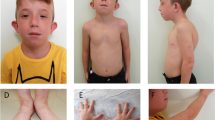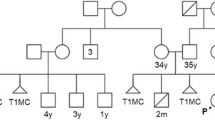Summary
A syndrome due to 3:1 meiotic segregation of balanced 11/22 translocation is defined from nine personally observed patients and 22 cases from the literature with apparently the same aberration. Frequent findings include a characteristic face with deepset eyes, flat nose, prominent upper lip, receding mandible and preauricular pits or tags, male genital hypoplasia, anal atresia or other anomalies of the anus, cleft palate, and congenital heart defect. Less frequent are severe reduction of the auricles, an additional pair of ribs, and hypoplasia of the diaphragm. Perinatal mortality is high. Growth is usually and psychomotor development is invariably and severely delayed. Balanced 11/22 translocations are apparently disproportionally frequent; as the balanced rearrangement is not easy to detect, it is important to be aware of it at the family investigation of cases with extra chromosomes similar to a No.22 or 22q-.The unbalanced products are most probably trisomic for both a segment of 22 (22q-) and a distal segment of 11q; the exact determination of the breakpoints is not possible at present due to the similar banding characteristics of the two segments involved in the translocation.
Similar content being viewed by others
References
Alfi OS, Sanger RG, Donnell GM (1975) Trisomy 22.A clinically identifiable syndrome. Birth Defects 11:241–245
Al Saadi A, Yang SS, Singla P (1977) Partial trisomy of chromosomes 22 and 16 in a microphtalmic infant. Am J Hum Genet 29:18A
Aurias A, Turc C, Michiels Y, Sinet PM, Graveleau D, Lejeune J (1975) Deux cas de trisomie 11q(q231→qter) par translocation t(11;22)(q23;q111) dans deux familles differentes. Ann Genet (Paris) 18:185–188
Ayraud N, Galiana A, Lloyd M, Deswarte M (1976) Trisomie 11q(q23.1→qter) par translocation maternelle t(11; 22)(q23.1;q11.1). Une nouvelle observation. Ann Genet (Paris) 19:65–68
Bader PI, Jansch M, Hoffman D, Palmer CG, Gerber H, Taylor G (1978) Trisomy 11q(q21→qter). Birth Defects 14:383–392
Bass HN, Crandall BF, Sparkes RS (1973) Probable trisomy 22 identified by fluorescent and trypsin-Giemsa banding. Ann Genet (Paris) 16:189–192
Begleiter ML, Kulkarni P, Harris DJ (1976)Confirmation of trisomy 22 by trypsin-Giemsa staining. J Med Genet 13:517–520
Biederman BM, Lin CC, Lowry RB, Somerville R (1980) Tertiary trisomy (22q11q),47,+der(22),t(11;22). Hum Genet 53:173–177
Bofinger MK, Soukup SW (1977) Cat's eye syndrome. Partial trisomy 22 due to translocation in the mother. Am J Dis Child 131:893–897
Borgaonkar DS, McKusick VA, Farber PA (1973) An inherited small extra chromosome. A mother with 46,XX,t(17;22) (p1;q1) and a son with 47,XY,+der(22)mat. J Med Genet 10:379–384
Bühler EM, Méhes K, Müller H, Stalder GR (1972) Cat's eye syndrome, a partial trisomy 22. Hum Genet 15:150–162
Curcio S (1967) Malformazione del retto e della vagina associata ad anomalia cromosomica (47,XX,?G+). Arch Ostet Ginecol 72:533–539
Emanuel BS, Zackai EH, Aronson MM, Mellman WJ, Moorhead PS (1976) Abnormal chromosome 22 and recurrence of trisomy-22 syndrome. J Med Genet 73:501–506
Feldman GM, Sparkes RS (1978) The problem of partial trisomy 22 reconsidered. Hum Genet 45:97–101
Fitzgerald PH (1976) Evidence that chromosome band 22q12 is concerned with cell proliferation in chronic myeloid leukaemia. Hum Genet 33:269–274
Foerster W, Fuhrmann W, Gutermuth M (1975) Partielle Trisomie 22 bei fraglichem Cat eye-Syndrom. Verh Ges Anthrop Humang. G. Fischer, Stuttgart, p 233
Francke U, Weber F, Sparkes RS, Mattson PD, Mann J (1977) Duplication 11 (q21 to 23→qter) syndrome. Birth Defects 13:167–186
Garlinger P, McGeary SA, Magenis E (1977) Partial trisomy 22: a recognizable syndrome. Clin Genet 12:9–16
Giraud F, Mattei JF, Mattei MG, Bernard R (1975) Trisomie partielle 11q et translocation familiale 11–22. Hum Genet 28:343–347
Gustavson KH, Hitrec V, Santesson B (1972) Three nonmongoloid patients of similar phenotype with an extra G-like chromosome. Clin Genet 3:135–146
Hall B (1963) Mongolism and other abnormalities in a family with trisomy 21–22 tendency. Acta Paediatr Scand Suppl 146:77–91
Hollingworth F, Kim CM, Falek A (1979) Partial trisomy 11q with familial 11q;21q translocation. Mammalian Chromosome Newsl 20:19
Hsu LYF, Shapiro LR, Gertner M, Lieber E, Hirschhorn K (1971) Trisomy 22: a clinical entity.J Pediatr 79:12–19
Ishmael J, Laurence KM (1965) A probable case of incomplete trisomy of a chromosome of the 13–15 group. J Med Genet 2:136–141
Jacobsen P, Hauge M, Henningsen K, Hobolth N, Mikkelsen M, Philip J (1973) An (11;21) translocation in four generations with chromosome 11 abnormalities in the offspring. A clinical, cytogenetical, and gene marker study. Hum Hered 23:568–585
Jotterand-Bellomo M (1976/77) Trisomie 22. Arch Genet (Zur) 49/50:134–166
Kadotani T, Katano T, Yamaoka H, Murakami M, Nakamoto Y, Watanabe Y(1978a) Clinical and cytogenetic features of a case with trisomy 22. Proc Jpn Acad 54:Ser B, 163–166
Kadotani T, Katano T, Yamaoka H, Murakami M, Nakamoto Y, Watanabe Y (1979b) A case of partial trisomy 22 without cat-eye stigmata. Proc Jpn Acad 54: Ser B, 217–221
Kessel E, Pfeiffer RA (1977) 47,XY,+der(11;22)(q23;q12)following balanced translocation t(11;22)(q23;q12)mat. Remarks on the problem of trisomy 22. Hum Genet 37:111–116
Laurent C, Biemont MC, Bethenod M, Cret L, David M (1975) Deux observations de trisomie 11q(q23.1→qter) avec la même anomalie des organes génitaux externes. Ann Genet (Paris) 18:179–184
Lindsten J, Therkelsen AJ,Friedrich U, Jonasson J, Steenstrup OR, Wiquist N (1974) Prenatal cytogenetic diagnosis. Int J Gynaecol Obstet 12:101–111
Lozzio CB (1969) Nonmongoloid trisomy G. Birth Defects 5:64–66
Macintyre MN, Hempel JM, Walden DB, Miller RC, Greene AE, Coriell LL (1975) A (17;22) translocation, balanced, 46 chromosomes. Repository identification No.GM-119. Cytogenet Cell Genet 14:80–81
Macintyre MN, Walden DB, Hempel JM (1971) Tertiary trisomy in a human kindred containing a E/G translocation. Am J Hum Genet 23:431–441
Malpuech G, Menut G, Raynaud EJ, Lavignon A (1970) Trisomie libre concernant un petit acrocentrique chez un sujet féminin non mongolien. trisomie 22 ou trisomie partielle. Pédiatrie 8:901–910
Moore MK, Engel E (1968) G chromosome trisomy: five cases with syndromes other than classical Down's. Southern Med J 61:146–154
Nakai H, Yamamoto Y, Kuroki Y (1979) Partial trisomy of 11 and 22 due to familial translocation t(11;22)(q23;q11) inherited in three generations. Hum Genet 51:349–355
Narahara K, Kodama Y, Kimura S, Kamoi M, Inoue H, Kimoto H (1979) A case of partial trisomy 22 resulting from maternal 11/22 translocation. Jpn J Hum Genet 24:253–258
Niermeijer MF, Sachs ES, Jahodava M, Tichelaar-Klepper C, Kleijer WJ, Galjaard H (1976) Prenatal diagnosis of genetic disorders. J Med Genet 13:182–194
Noel B, Levy M, Rethoré MO (1976) Trisomie partielle du bras long du chromosome 11 par malségrégation d'une translocation maternelle t(11;22)(q231;q111). Ann Genet (Paris) 19:137–139
Pai GS, Thomas GH, Leonard CO, Ward JC, Valle DL, Pyeritz RE (1979) Syndromes due to chromosomal abnormalities: partial trisomy 22, interstitial deletion of the long arm of chromosome 13, and trisomy 8. John Hopkins Med J 145:162–169
Parslow M, Hoo JJ, Garry M, Rose F (1980) A deleted extra chromosome 22 identified by DNA replication banding. Hum Genet 53:323–326
Penchaszadeh VB, Coco R (1975) Trisomy 22. Two new cases and delineation of the phenotype. J Med Genet 12:193–199
Petersen F, Dahl G (1977) Trisomi 22q-. Ugeskr Laeger 139:3061
Punnett HH, Kistenmacher ML, Toro-Sola MA, Kohn G (1973) Quinacrine fluorescence and Giemsa banding in trisomy 22. Theor Appl Genet 43:134–138
Ridler MA, McKeown JA (1979) 11q aneuploidy: partial monosomy and trisomy in the children of a mother with a (3;11)(p27;q23) translocation. Hum Genet 52:101–106
Schinzel A (1981a) Incomplete trisomy 22. II. Familial trisomy of the distal segment of chromosome 22q in two brothers from a mother with a translocation, t(6;22)(q27;q13). Hum Genet 56:263–268
Schinzel A (1981b) Incomplete trisomy 22. III. Mosaic-trisomy 22 and the problem of full trisomy 22. Hum Genet 56:269–273
Schinzel A, Schmid W, Fraccaro M, Tiepolo L, Zuffardi O, Opitz JM, Lindsten J, Zeterqvist P, Enell H, Bacichetti C, Tenconi R, Pagon RA (1981) The “Cat eye syndrome”: Dicentric small marker chromosome probably derived from a No.22 (tetrasomy 22pter→q11) associated with a characteristic phenotype. Report of 11 cases and delineation of the clinical picture. Hum Genet (in press)
Shanske A, Acs H, Kazi R (1979) Secondary meiotic nondisjunction in a carrier of a reciprocal translocation (11;22). Am J Hum Genet 31:110A
Shokeir MHK (1980) Complete trisomy 22. Clin Genet 14:139–146
Uchida IA, Byrnes EM (1976) Confirmation of trisomy 22 with fluorescence banding. Am J Hum Genet 30:189–190
Uchida IA, Ray M, McRae KN, Besant DF (1968) Familial occurrence of trisomy 22. Am J Hum Genet 20:107–118
Zellweger H, Ionasescu V, Simpson J, Burmeister L (1976) The problem of trisomy 22. A case report and a discussion of the variant forms. Clin Pediat 15:601–618
Zellweger H, Mikamo K, Abbo G (1962) Two cases of multiple malformations with an autosomal chromosomal aberration. partial trisomy D? Helv Paediatr Acta 17:290–300
Zergollern L, Hitrec V (1979) Partial trisomy 22. Acta Med Iugosl 33:459–470
Author information
Authors and Affiliations
Rights and permissions
About this article
Cite this article
Schinzel, A., Schmid, W., Auf der Maur, P. et al. Incomplete trisomy 22. Hum Genet 56, 249–262 (1981). https://doi.org/10.1007/BF00274675
Received:
Published:
Issue Date:
DOI: https://doi.org/10.1007/BF00274675




